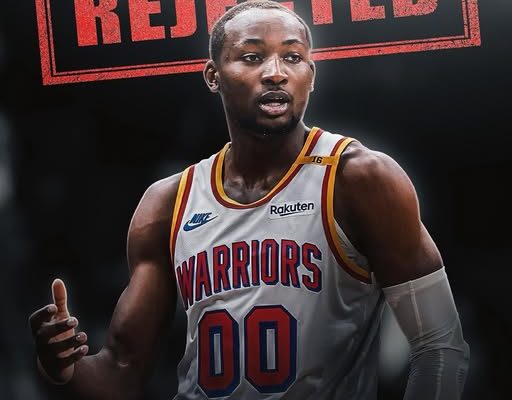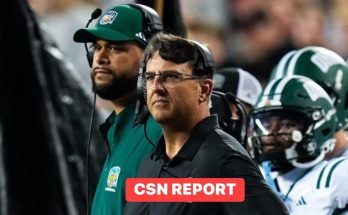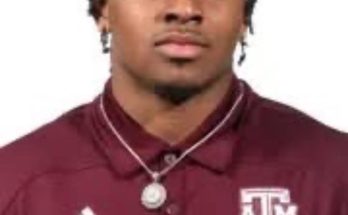The Golden State Warriors have found themselves in an increasingly precarious situation with forward Jonathan Kuminga, whose potential has long made him a focal point of the franchise’s long-term future. The franchise’s recent attempt to secure that future with a new contract has not gone according to plan. According to multiple reports, the Warriors’ best offer to Kuminga topped out at two years, $40 million—a significant payday for a young, still-developing player in the NBA. However, Kuminga and his camp rejected the deal, deeming it unsatisfactory, and the move has since fueled serious speculation about his future with the franchise and the direction the Warriors are choosing to take amid a shifting NBA landscape.
Kuminga, the seventh overall pick in the 2021 NBA Draft, has always been viewed as a high-ceiling prospect. His athleticism, defensive versatility, and flashes of offensive brilliance made him a key asset on a Warriors roster that was transitioning from one era of dominance to a retooling phase. But the journey has not been smooth for Kuminga. While he has grown considerably in his first three years in the league, his role under head coach Steve Kerr has been a point of contention. Kuminga’s minutes have fluctuated wildly, and despite being one of the most athletic and energetic players on the team, he has often found himself relegated to the bench in crucial moments.
This context adds fuel to the recent contract drama. The Warriors’ offer of $40 million over two years signals a desire to retain Kuminga in the short term, perhaps to keep flexibility open for future moves or roster evolution. However, for Kuminga and his representatives, the short-term nature of the deal likely signals a lack of long-term faith in his potential to become a cornerstone of the franchise. Considering the recent market for players of Kuminga’s archetype—young, improving wings with defensive upside—the deal feels underwhelming when compared to what other teams might offer in a more open bidding environment.
Rejection of the $40 million offer isn’t just about money; it’s about role, respect, and opportunity. Kuminga is 21 years old, coming off a season in which he averaged career highs in points, rebounds, and shooting efficiency. He displayed moments of real dominance when given extended playing time, and he was one of the few Warriors players to bring consistent energy during their disappointing playoff exit. That context makes the team’s lowball offer all the more puzzling. There’s a disconnect between how the Warriors are valuing Kuminga financially and how he has begun to assert himself as a vital piece of the team’s evolving identity.
One could argue that the Warriors are in a tough spot. The franchise is still straddling the line between contending for championships with its aging core of Stephen Curry, Klay Thompson, and Draymond Green, and developing its younger pieces like Kuminga, Moses Moody, and Brandin Podziemski. The balance has not been easy to strike. James Wiseman, the former No. 2 overall pick, was traded after the franchise concluded that he didn’t fit their current competitive timeline. Jordan Poole was moved to clear the way for chemistry and cap flexibility. Kuminga now represents one of the last high-upside draft picks still on the roster, and his rejection of the Warriors’ best offer suggests that time may be running out on this experiment too.
From Kuminga’s perspective, the rejection makes perfect sense. At his age and with his trajectory, he would likely command a longer-term deal in a more open market, especially from teams that can offer a consistent starting role and a commitment to development. A two-year deal carries little security, and it places the burden of continued performance entirely on the player, while the franchise retains flexibility to trade or pivot as it chooses. It’s a contract structure that favors the team, not the player. Kuminga’s refusal to accept such terms is a sign that he sees himself as more than a role player riding the coattails of a championship core. He sees himself as a potential star who deserves a contract reflecting that belief.
The Warriors’ front office is walking a tightrope here. On one hand, they want to stay under the luxury tax threshold that has become increasingly punitive under the NBA’s new collective bargaining agreement. On the other hand, they can’t afford to alienate or lose one of the only players on their roster who can keep the team relevant beyond the Curry era. Failing to secure Kuminga long-term could result in a scenario where he walks away for nothing, or worse, forces a trade that results in a talent downgrade. The Warriors have already been burned by poorly timed exits, and they may now be risking yet another in Kuminga.
In the short term, the rejection of the deal adds an unwelcome distraction to training camp and preseason preparation. Every press conference will now include questions about Kuminga’s future. Every misstep or moment of benching will be analyzed as a potential signal of discontent or brewing trade tension. Meanwhile, rival teams are surely watching with interest. The idea of adding a 21-year-old wing with elite athleticism and untapped potential is tantalizing for franchises with cap space and a vision for the future. If the Warriors aren’t careful, they could see Kuminga walk away and become a star elsewhere—much like what they feared with Poole before his eventual trade.
Steve Kerr’s role in this drama cannot be overlooked. Kuminga has previously expressed frustration with his inconsistent playing time, and many around the league believe that Kerr has not fully bought into Kuminga as a long-term building block. That divide, whether philosophical or personal, adds another layer to the failed contract negotiation. If Kuminga does not feel supported by the coaching staff, even a more lucrative offer might not be enough to secure his commitment. Trust, in this case, might be harder to build than dollar signs.



